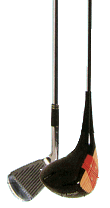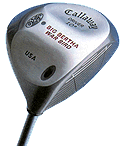A History of the Golf Club
Modern Golf Clubs
Up to the 1930s there was a rich variety of clubs available using both modern and traditional materials. To prevent golfers using an inordinate numbers of clubs and to promote individual skill, the R&A introduced it's 14 club rule in 1939. The modern convention for numbering woods and irons rather than naming them dates from this period. 
Since the end of World War II, golf club development has been influenced by research into synthetic and composite materials. The casting method of manufacturing clubs heads was introduced in 1963. This made clubs more affordable than ever. However, professional golfers continue to use hand forged ones because of the increased 'feel' and therefore control. The now very common putter, the centre shafted putter, was only legalised by the R&A in 1951.
The graphite shaft was introduced in 1973 which offers rigidity, lightness and increased strength over steel shafts. Modern graphite shafts are manufactured with other materials to improve their performance; boran is used to reduce twisting. Most amateur golfers still use steel shafted clubs because of their affordability.
 Taylor-Made was the first company to manufacture metal woods. Only recently have they become more popular than persimmon woods. The most successful club in history is Callaway's over sized wood, the Big Bertha which was introduced in 1991. Today there is an enormous variety of woods to choose from. The latest trend is woods with titanium heads and graphite shafts which are very expensive.
Taylor-Made was the first company to manufacture metal woods. Only recently have they become more popular than persimmon woods. The most successful club in history is Callaway's over sized wood, the Big Bertha which was introduced in 1991. Today there is an enormous variety of woods to choose from. The latest trend is woods with titanium heads and graphite shafts which are very expensive.
Antique golf clubs are avidly collected and are becoming increasingly valuable. An Allan Robertson hickory longnose would easily fetch a four figure sum at auction.
...previous page...

